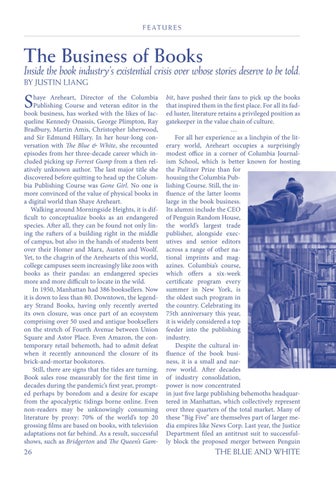F E AT U R E S
The Business of Books
Inside the book industry’s existential crisis over whose stories deserve to be told. BY JUSTIN LIANG
S
haye Areheart, Director of the Columbia Publishing Course and veteran editor in the book business, has worked with the likes of Jacqueline Kennedy Onassis, George Plimpton, Ray Bradbury, Martin Amis, Christopher Isherwood, and Sir Edmund Hillary. In her hour-long conversation with The Blue & White, she recounted episodes from her three-decade career which included picking up Forrest Gump from a then relatively unknown author. The last major title she discovered before quitting to head up the Columbia Publishing Course was Gone Girl. No one is more convinced of the value of physical books in a digital world than Shaye Areheart. Walking around Morningside Heights, it is difficult to conceptualize books as an endangered species. After all, they can be found not only lining the rafters of a building right in the middle of campus, but also in the hands of students bent over their Homer and Marx, Austen and Woolf. Yet, to the chagrin of the Arehearts of this world, college campuses seem increasingly like zoos with books as their pandas: an endangered species more and more difficult to locate in the wild. In 1950, Manhattan had 386 booksellers. Now it is down to less than 80. Downtown, the legendary Strand Books, having only recently averted its own closure, was once part of an ecosystem comprising over 50 used and antique booksellers on the stretch of Fourth Avenue between Union Square and Astor Place. Even Amazon, the contemporary retail behemoth, had to admit defeat when it recently announced the closure of its brick-and-mortar bookstores. Still, there are signs that the tides are turning. Book sales rose measurably for the first time in decades during the pandemic’s first year, prompted perhaps by boredom and a desire for escape from the apocalyptic tidings borne online. Even non-readers may be unknowingly consuming literature by proxy: 70% of the world’s top 20 grossing films are based on books, with television adaptations not far behind. As a result, successful shows, such as Bridgerton and The Queen’s Gam-
26
bit, have pushed their fans to pick up the books that inspired them in the first place. For all its faded luster, literature retains a privileged position as gatekeeper in the value chain of culture. … For all her experience as a linchpin of the literary world, Areheart occupies a surprisingly modest office in a corner of Columbia Journalism School, which is better known for hosting the Pulitzer Prize than for housing the Columbia Publishing Course. Still, the influence of the latter looms large in the book business. Its alumni include the CEO of Penguin Random House, the world’s largest trade publisher, alongside executives and senior editors across a range of other national imprints and magazines. Columbia’s course, which offers a six-week certificate program every summer in New York, is the oldest such program in the country. Celebrating its 75th anniversary this year, it is widely considered a top feeder into the publishing industry. Despite the cultural influence of the book business, it is a small and narrow world. After decades of industry consolidation, power is now concentrated in just five large publishing behemoths headquartered in Manhattan, which collectively represent over three quarters of the total market. Many of these “Big Five” are themselves part of larger media empires like News Corp. Last year, the Justice Department filed an antitrust suit to successfully block the proposed merger between Penguin
THE BLUE AND WHITE




